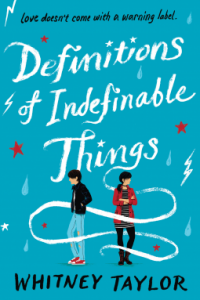
Whitney Taylor
HMH Books for Young Readers
Published April 4, 2017

Amazon | Barnes & Noble | Goodreads
About The Definition of Indefinable Things
This heartbreaking, humorous novel is about three teens whose lives intersect in ways they never expected.
Reggie Mason is all too familiar with “the Three Stages of Depression.” She believes she’s unlocked the secret to keeping herself safe: Nobody can hurt you if you never let them in.
Reggie encounters an unexpected challenge to her misanthropy: a Twizzler-chomping, indie film-making narcissist named Snake. Snake’s presence, while reassuring, is not exactly stable—especially since his ex-girlfriend is seven months pregnant. As Reggie falls for Snake, she must decide whether it’s time to rewrite the rules that have defined her.
My Review
Reggie’s a prickly girl, so it took me a little bit to warm up to her. I tend to struggle with those kinds of narrators because I find the sort of determined negativity exhausting. What won me over with Reggie was the hints at her underlying sadness and the quirky, fun banter between her and Snake.
Snake totally seemed like the kind of character author Matthew Quick would come up with, and I really couldn’t help liking him, even though clearly he was working through some big issues and not always making the best choices. I liked that he wanted to do right by his and Carla’s baby, even when he wasn’t sure what that meant for his relationship with Carla.
The story sort of meandered in some places, lingering long on the mystery of what triggered Reggie’s depression, and her fears about a potential relationship with Snake. I loved the moment when she’s able to reach out to him using her own experience with depression. I liked that their relationship never came easily, but that they had to find their own ways to trust and be open with each other.
Books where Christianity or devout Christians are disparaged or portrayed in a negative light tend to be difficult for me as well, not because I think it can’t happen that way, but because I feel like too often that’s the narrative. I can’t help sometimes feeling like we allow a lot more latitude for negative portrayal of Christianity in modern young adult literature than we do other faiths or worldviews, but that’s a whole separate soap box. For Definitions of Indefinable Things, I think while Reggie was pretty tough on her mom and her beliefs, eventually they began to see value in each other’s perspectives and to find ways to express their love for each other without compromising what they believed, which felt real and honorable.
If you liked Every Exquisite Thing by Matthew Quick or The Paradox of Vertical Flight by Emil Ostrovski, you should check out Definitions of Indefinable Things.
Cultural Elements
Reggie describes Snake as having olive skin and dark, curly hair. He has two moms, one of whom has brown skin. Other characters are white.
Profanity/Crude Language Content
Strong profanity used moderately frequently.
Romance/Sexual Content
Kissing between a boy and girl. References to sex. One character is pregnant.
Spiritual Content
Reggie’s mom is a devoted Christian and hopes prayer will heal Reggie’s depression. Reggie internalizes this as pressure to change. Like she’s supposed to magically become the person her mom wants her to be. Reggie herself prays in a couple of desperate situations, but otherwise doesn’t embrace any spirituality. She often disparages her mom’s beliefs.
Violent Content
None.
Drug Content
Snake confesses that he slept with a girl at a party where both had been drinking alcohol.